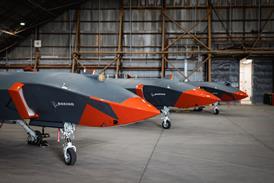Air Baltic chief executive Martin Gauss remains confident in the prospects for the airline’s initial public offering, despite its being pushed back at least to the first half of next year.
Speaking to FlightGlobal in London, Gauss said the “market is not right” for the IPO from which the carrier aims to raise €300 million ($315 million).
“We have a concept which is proven to work – both wet-lease and scheduled flying – therefore we’re very positive about the business plan,” he says. “We have a strong team, the senior management is very capable of doing the job – but we need to have investors pay the right price.”
Air Baltic wants to strengthen its balance sheet with the new equity. Gauss says the carrier has an “expensive bond”, which the company can refinance with a better interest rate in 2026. The equity and the lower bond will “significantly leverage” the airline, he states.
He says the airline is in “advanced discussions” with a large international listed airline for a pre-IPO investment, and expects to attract interest from potential investors in other sectors – particularly the Baltic retail market.

“We are the most known brand in the Baltics,” says Gauss, claiming that 98% of the population is aware of the carrier. “We have a very strong lever here on retail.”
He believes the airline will secure investment from a broad group. “We’ll see in the end who does it,” he says. “But it’s not that the airline [will be] sold [only] to two parties.”
The Latvian government is Air Baltic’s primary shareholder, holding almost all the capital, and Gauss acknowledges that the governments of neighbouring Estonia and Lithuania have shown interest in the IPO – although this would not necessarily translate into direct investment.
“There is public debate about this in the two countries,” says Gauss. “Does it make sense for these governments [to invest]…what do they gain?”
He suggests the Lithuanian government is not keen to return to airline ownership, while the Estonian government has been wrestling over the wisdom of public airline management during the – ultimately unsuccessful – attempt to rescue regional operator Nordica, set up to replace the prior state-owned carrier Estonian Air.

Gauss does not envision the Baltic states as investors in Air Baltic in the sense of the trinational model previously illustrated by the Scandinavian states in SAS.
“I’d rather see the strong co-operation which we have today with these neighbouring [Baltic] states,” he says, pointing out that Lithuania has a risk-sharing model for flying certain routes.
“That’s also supporting, as a state, the airline. But it’s a more modern way than, ‘I’m a state and I own an airline’. I think that model is old-fashioned.”
Air Baltic is already the “de facto national carrier” in Estonia, claims Gauss, and he is interested in strengthening the airline’s position there, especially since the loss of Nordica.
“I always saw, in the neighbouring states, I always saw the ambition, and the plans, and the rhetoric was always excellent about how they’d kill us,” he says. “But at the end of the day, to set up a scheduled airline today in Europe [and] grow it successfully, you need a lot of money.”
He points out that competition in Europe is not limited to any individual country, but “goes basically through all the hubs” and setting up a new airline in the Baltics ultimately means competing with a multitude of carriers offering connections via their hubs.
Concentrating on connectivity has been crucial to Air Baltic’s survival, Gauss believes: “In Europe, connectivity is the economic driver, not the number of passengers.”
“We’re a low-cost airline, and more passengers is better. But our model is built on connectivity and there are a lot of places in Europe where [losing that focus] has failed,” he says. “We ensure connectivity and have always done it through Riga as a hub.”
He says this “comes at a cost” because hubs bring down utilisation compared with point-to-point operations. But Gauss adds that the carrier’s use of Airbus A220s give it a year-round competitive edge over budget airlines using larger Boeing 737s.

Part of the connectivity strategy includes 24 codeshare partnerships. Gauss believes these offer greater network coverage than membership of an alliance.
Air Baltic has almost reached a fleet of 50 A220s, eight years after receiving its first, and it has options and rights for 50 more, taking its fleet to around 100 by 2030. Gauss says there is space to expand in the Baltic region outside of Latvia.
The carrier is basing three aircraft in Vilnius and four in Tallinn for the summer, and Gauss sees room to double these fleets, while operating 26 jets from other locations and using 30 for wet-lease activity. It operates wet-lease services for Lufthansa Group carriers.
Gauss indicates that Air Baltic would consider expanding in the Nordic region and, if the conflict ends, Ukraine.
Air Baltic is developing its training capabilities along with its fleet. It has acquired a second A220 simulator which will become operational at its Riga centre, replacing a former Boeing 737 installation. The second simulator will avoid the need to send pilots to other facilities as the fleet expands and, while it is not yet available for third-party training, this could be an option in future.


























